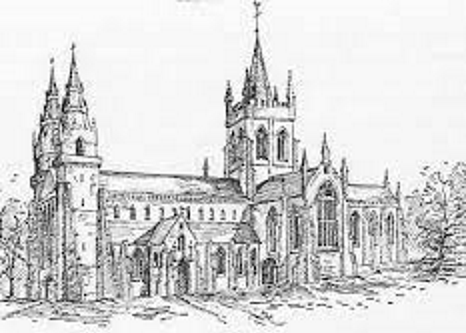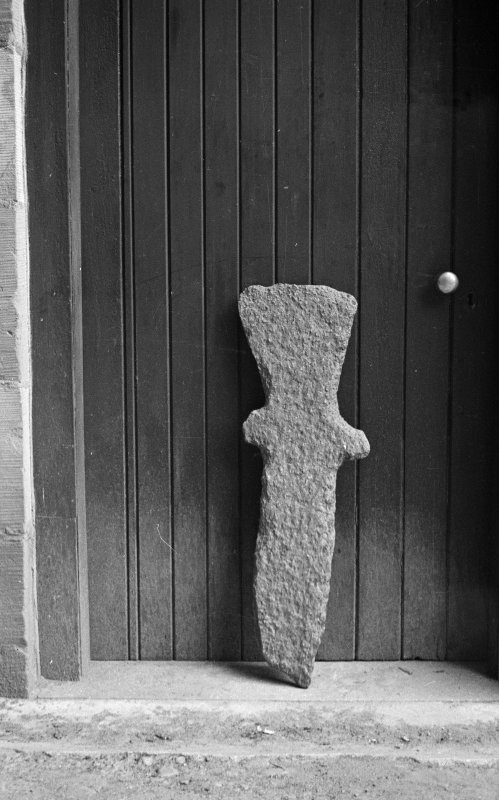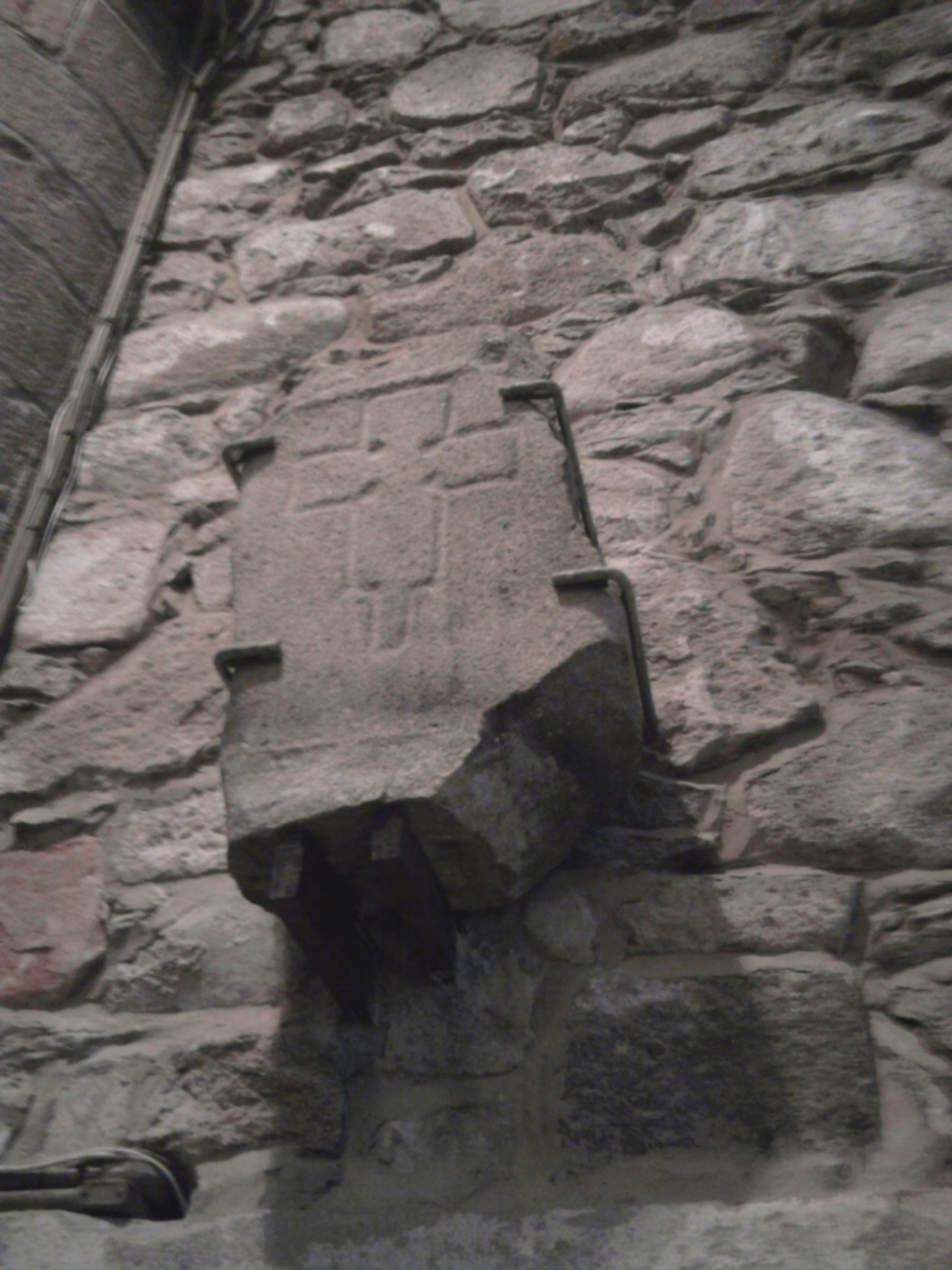
The Diocese of Aberdeen
Although the first diocesan bishop of Aberdeen was an individual who bore a singularly Pictish name - Nechtan - those that followed had, mostly, 'southern' names (Edward 1147-1171, Matthew 1172-1199, John 1199-1207, and Adam 1207-1228). Before their consecrations, a significant number of these individuals had had careers within the Royal Household, or had held high office in one of the Scottish monasteries, and their 'roots' were often to be found in 'lowland', if not Norman, families. However, whoever they were, these were the 'builders' of the early Diocese.
It is unfortunate that certain writers have continued to tell the 'fabulous' foundation story which relates that there had been a Diocese of Mortlach before the time of Bishop Nechtan (c.1131). Most modern historians now consider this to be a spurious tale. The diocesan 'structure' that we recognize today is a product of the Anglo-Norman influences brought to bear in the north by the Scottish Royalty, particularly Kings Alexander I (d.1124) and David I (d.1153). There certainly were bishops operating in Northern Scotland before the dioceses were created, but these were 'wandering bishops' (episcopi vagantes) who traveled far and wide to attend to the needs of the early communities. They were simple priests who, because of their episcopal orders, were needed to teach, to consecrate churches and to administer confirmation to those individuals who wished it. In those days, according to Church Law, it was not possible for those in priest's orders, or below, to carry out such duties which meant that communities had to wait for a bishop to visit them in order that they could receive these episcopal ministrations.
When the first dioceses were created, an understandable attempt was made by certain bishops to gain 'seniority'. Until 1472 Scotland did not have the services of an archbishop to act as 'the captain of the ship' so, in these early centuries, according to Canon Law, all the bishops were equal. But this proved to be awkward, to say the least! The situation reduced itself to various attempts aimed at determining whose diocese was 'senior' and this ultimately revolved around the question of whose was the first to be founded. Consequently, there was a distinct advantage to be had by a bishop who could prove his diocese's antiquity. Aberdeen was very much a part of this and many historians now believe that it is here that we have the real motivation behind the creation of the spurious 'diocese of Mortlach'. The truth is that there was indeed a Christian community (muinntir) at Mortlach (and at Dunmeath) which could trace its roots to the time of St Moluag. Also, there would have been numerous visitations of various episcopi vagantes to this community and so it is quite proper to say that there was, from time to time, "a bishop
It would be well to stop for a moment and ponder the question as to why Mortlach, of all places, was chosen by the early 'peregrines' who spent their lives bringing the Faith to these northern parts. It would seem to be such an out-of-the-way location! We should first remind ourselves of the geography of the north in these early days. The main routes for travelers ran north to south, from Morayshire to Angus and beyond. Of all these tracks, one of the most important was that which we now call the Firmounth Road which employed the ford-crossing of the formidable River Dee at Cobleheugh

© Historic Environment Scotland
All sorts of stories about how the cathedral came to be founded at Old Aberdeen by an individual called St Machar, were also created at this time, but they, too, are a mixture of fable seasoned with fact.2
Cosmo Innes was quite uncompromising in his treatment of the 'evidence' that is available to us. It consists of five of the earliest charters found in the Register of Aberdeen. He said that they,
" … would have been very important for settling this [foundation] question, if they could be relied upon as genuine. Unfortunately, it is not so. The first charter printed … which was certainly meant to pass for one of Malcolm Canmore, has been very generally denounced as a palpable forgery; and it must be admitted. that neither it, nor the following charter of David, nor the three which profess to be of Malcolm IV., can be sustained as genuine … "3
If we accept the seemingly unavoidable conclusion that all five charters are forgeries, then it would point to a strenuous effort on someone's part to falsify the history of the foundation of the cathedral of Aberdeen. As we have said, this could well have been part of a propaganda exercise employed to suggest that the diocese was of greater antiquity, and therefore 'seniority', than was actually the case. But, as to motive, Innes was inclined to be more generous, suggesting that the errors occurred as the result of inaccurate copying by a scribe of a later date. Some of the charters in question contain records of 'subjects' which were of great value to the church, and which it might be thought advantageous to ascribe to a foundation since they were purported to be ancient grants of King David and his grandson. Potentially, they could have had a significant impact. They were too important, perhaps, to just cast off as forgeries. Innes went on to suggest that:
"… even if some of these charters are to be viewed as constructed out of ancient memorials and put into a formal legal shape to serve a law purpose, or as true entries tampered with by an ignorant copyist, it is unsafe for an enquirer into the History of the Diocese to draw facts or dates from any of them."4
This may be so but, of course, the outcome was still a tale which enhanced the bishop of Aberdeen's 'seniority' amongst his peers.
This matter was of such historical importance that, at the Twenty-sixth Annual General Meeting of the New Spalding Club, held on 27 December 1912, it was resolved to appoint a Committee to examine and report upon the genuineness and authenticity of certain documents contained in "Registrum Episcopatus Aberdonensis". A number of months later, Mr John Milne presented a memorandum, drawn up by that committee, to the Spalding Club (in 1914) which, in general terms, condemned the authenticity of the charters.
To return to safer ground, we know that there was, indeed, an early Christian community in the vicinity of the present location of St Machar's Cathedral, as is demonstrated by the discovery of a cross-incised stone within the chanonry5 .

© HES Canmore Database.
When a site was being looked for, where a cathedral could be built for the new diocese, the site of this ancient community would have presented itself as being ideal because of its great antiquity. As has been said, to have ancient antecedents was a distinct advantage in these days and it did not require any dream of Colum Cille or searches for crozier-shaped meanders in the River Don to determine the best site. It was, after all, at the heart of the community - Old Aberdeen having now become a significant population centre, although as yet, New Aberdeen where the church of St Nicholas was eventually built, consisted only of a few huts. The muinntir near Old Aberdeen would have been able to offer all kinds of support to the fledgling cathedral.
Aberdeen, then, was the sixth diocese to be established in Scotland6 but it would seem that in these early days of the diocese the establishment of the cathedral building itself made only slow progress. By the time we get to 1157 it was not even clear what sort of cathedral foundation was intended. On 10 August of that year, the Pope7 issued a bull confirming that Aberdeen was clearly now the site of the cathedral of the diocese, but that there was, apparently, no community of clergy yet in place to serve it properly. Edward I., the second Bishop of Aberdeen (1147-1171), received a papal faculty to introduce monks or canons into his cathedral which would suggest that his intention might have been to provide a community of regular monks rather than secular clergy to form a Chapter.8 This would have resulted in Aberdeen following the contemporary examples of St Andrews and perhaps Whithorn in Galloway insofar as the cathedral's Chapter would have been composed of canons regular as opposed to lay canons; but no immediate advantage seems to have been taken of this faculty.
The Scottish bishops were not isolated from Rome and from 3-6 December of 1201 we find John of Salerno9 acting as Papal Legate at a Provincial Council held at Perth. John had the authority to act at this Synod as an archbishop would have done should Scotland have had one. The Pope occasionally appointed one of the Scottish bishops to act in a purely administrative way across the province - calling meetings and Synods, etc., but he was not given any authority over, or precedence amongst, his fellow bishops. We even have occasions when a Scottish bishop was appointed Legatus a Latere in Scotland.10, 11
In 1266, being the ninth year of the episcopate of Richard de Poiton (Potton), then Bishop of Aberdeen, after having inspected the statutes of the Church and with the consent of the Dean and Chapter, declared the church of St Mary and the church of St Machar to be one church cathedral, baptismal and parochial, all the revenues of which should be at the disposal of the Dean and Chapter for the support of the Church; and the Bishop granted, for the same purpose, the churches of Dunmeth (Dunmeath) and Cloueth (Clova), of which he was the patron.
Towards the end of 1359, during the episcopate of Bishop Alexander de Kininmund, a provincial council was held at Aberdeen at which a bull of Pope Adrian IV., containing the ancient foundation rights of the See, was exhibited and accepted as genuine. There was no mention of the alleged foundation charter of King David (vide supra) being amongst the other charters authenticated at the same council.
References.
1. On early Ordnance Survey maps the site of the muinntir at Clova is marked as "St Luke's Chapel"
2. Many rely on the work of Fordun, but we should consider these words from the Preface to the Registrum Episcopatus Aberdonensis:
"Now, not to mention that the assertion of a person writing about 1400, and quoting no authority, is very insufficient evidence of facts dated in 1011, the account of Fordun will be seen to be essentially built upon the tradition of the Church of Aberdeen, which, however, he has falsified or mistaken, by substituting Malcolm II. for Malcolm III. of the episcopal registers." [Innes (1845), i., xvi]
The Album Registrum is claimed to contain the oldest existing records of the bishopric of Aberdeen. The Table of its contents includes:
Anno Domini Mo · Septuagesimo · Malcolmus Rex Scotorum filius Kenachi duxit in uxorem beatam Margaretam reginam ... Et anno regni sui sexto fundata est sedes episcopalis apud Morthlach ut habetur in primo folio primi quaterni · Et processu temporis translata est sedes episcopalis apud Aberdon per David filium suum Regem Scocie et dotata vt habetur in eodem folio ·
Litera predict Malcolmi Kanmor de fundatione sedis episcopalisbapud Morthlach .
Tres litere Malcolmi pronepotis sui regis Scocie confirmantis donaciones Dauid regis Scosie aui sui ·
Litera Dauid regis Scocie filii primi Malcolmi et beate Margarete concedentis et donatis multas possessiones ecclesias et decimas omnium reddituum suorum inter duas aquas que Dee et Spee dicuntur ·
"The writer of this record mistakes the father of Malcolm III., whom he calls Kenneth instead of Duncan. Nor can there be any doubt that it is Malcolm III. of whom he speaks, notwithstanding his mistaken patronymic, when he mentions David I. as his son, and Malcolm IV. as his great-grandson, and bestows upon him his well-known appellation of 'Canmor'". [Return]
3. Innes (1845), i., xi-xii. [Return]
4. Innes (1845), i., xii. [Return]
5. A cross-incised stone was discovered c.1914 incorporated into a boundary wall of the old Seton estate, at Don Street, Old Aberdeen, only a little distance from St Machar's Cathedral. It is now securely fitted to the north-west interior wall of the cathedral. It is described as being of 'Early Christian' origin, possibly seventh-century. It is difficult to determine where exactly the cross lay before being incorporated into the boundary wall, but it is assumed that it was somewhere close to the cathedral. [http://canmore.org.uk/site/20182] The stone is dated by some to c.580AD. Observers might remark that the stone has been placed in a singularly inauspicious position considering that it must represent the oldest Christian memorial in the cathedral. [Return]
6. The dates when the Scottish diocese are commonly accepted to have been established are: St Andrews (before 1055); Glasgow (1055x1060); Dunkeld (1106/7); Moray (1107); Ross (1127x1131); Aberdeen (1131x1132); Caithness (1147x1151); Brechin (c.1150); Dunblane (1155); and Argyle (1183x1189), which was formed out of Dunkeld.
Orkney (before 1025) and The Isles (before 1074) were not Scottish diocese at first - they were subject to the Archbishop of Nidaros (Trondheim). [Return]
7. Pope Adrian IV (1154-1159), the Englishman, Nicholas Breakspear. His Bull of 1157, addressed to Bishop Edward, is reproduced in full in [Innes (1845), p.5.] [Return]
8. "Preterea monachos sive canonicos in tua cathedrali ecclesia juxta dispositionem tuam institudendi liberam auctoritate sedis apostolice habeas facultatem." [Innes (1845), p.6]
(
The principal signatory of the bull was Roland, cardinal-presbyter and chancellor of the Curia. The Pope's 'sign' along with those of eight cardinals were appended. (After a private conversation with Salvador Miranda at Florida International Universities, we agreed that this cardinal was Rolando Bandinelli, later Pope Alexander III (d.1181). He was named chancellor of the Holy Roman Church in 1153, and occupied the post until his election to the papacy on 7 September, 1159.) [Return]
9. John of Salerno, a Benedictine monk of Monte Cassino who had been made Cardinal-Priest of St Stephen al Monte Celio in September 1190, was an experienced cleric, having already served as Papal Legate in Germany and Italy. After the Synod in Perth he traveled to Ireland via Galloway. He was back at Lochmaben before 10 July 1202 and from there he spent some 50 days at Melrose Abbey, going from there to Ripon where he spent Christmas 1202 in the company of the Archbishop of York (Geoffrey Plantagenet). From there he traveled back to Italy after a second visit to Ireland, arriving in the Curia sometime in 1203. [Return]
10. It is known that Henry Wardlaw, bishop of St Andrews, acted as Papal Legate in Scotland on 5 August 1427 and 21 September 1430. [CSSR, ii., p.160, 135.] Bishop Thomas Spens of Aberdeen was 'conservator of the privileges of the Scotch church' in 1459, and presided at a provincial council on the 19th July. [Abdn. Reg., i., xl.] [Return]
11. Hugh de Benham, Bishop of Aberdeen (1272 - 1282), is said to have presided in a provincial council assembled at Perth, for the settlements of certain disputes regarding small tithes. [R.E.A., i., xxv-xxvi] [Return]
Bibliography.
Dunlop, A.I. (1956) Calendar of Scottish Supplications to Rome 1423-1428, Edinburgh: for the Scottish History Society. [CSSR, ii] [https://digital.nls.uk/scottish-history-society-publications/browse/archive/125885878#?c=0&m=0&s=0&cv=7&xywh=-323%2C0%2C2260%2C2739]
Innes, C. (1845) Registrum Episcopatus Aberdonensis, Vol. 1, Aberdeen: for the New Spalding Club. https://archive.org/details/registrumepisco01innegoog/page/n7/mode/2up
Milne, J. (1914) Registrum Episcopatus Aberdonensis: memorandum for the Spalding Club, Aberdeen: for the New Spalding Club.
e-mail: admin@cushnieent.com
